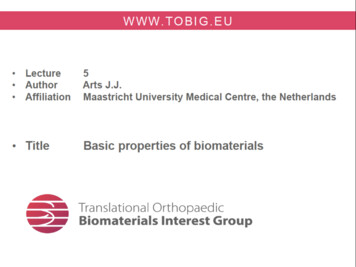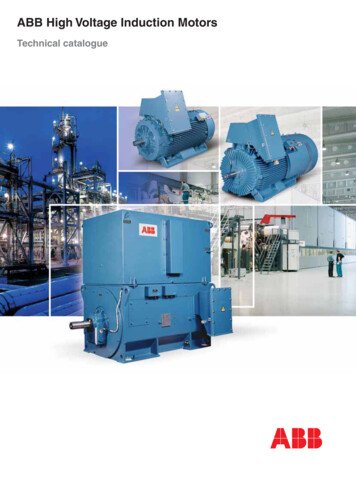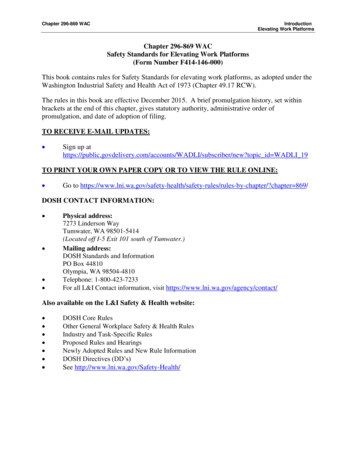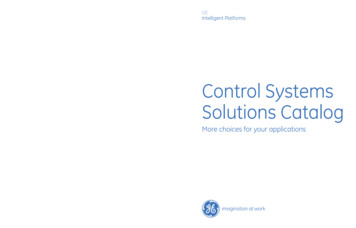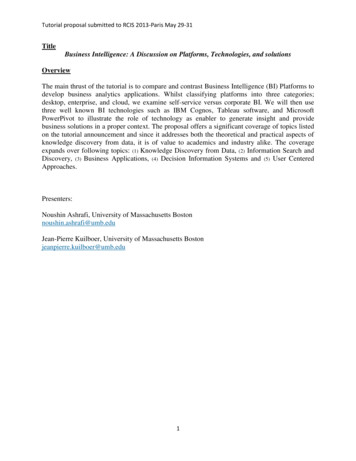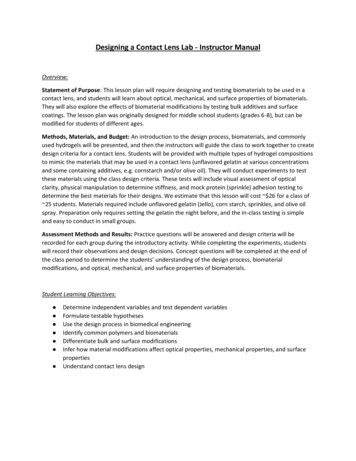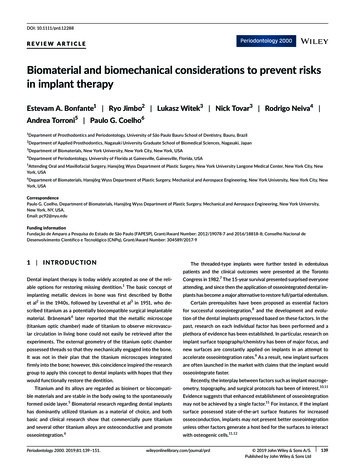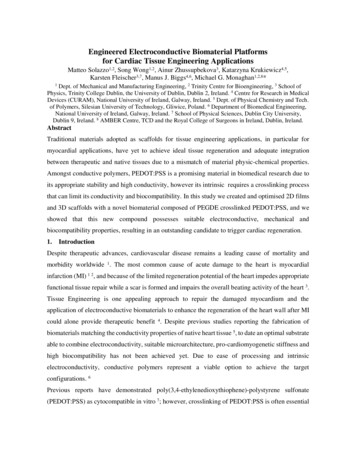
Transcription
Engineered Electroconductive Biomaterial Platformsfor Cardiac Tissue Engineering ApplicationsMatteo Solazzo1,2, Song Wong1,2, Ainur Zhussupbekova3, Katarzyna Krukiewicz4,5,Karsten Fleischer3,7, Manus J. Biggs4,6, Michael G. Monaghan1,2,8*1 Dept. of Mechanical and Manufacturing Engineering, 2 Trinity Centre for Bioengineering, 3 School ofPhysics, Trinity College Dublin, the University of Dublin, Dublin 2, Ireland. 4 Centre for Research in MedicalDevices (CURAM), National University of Ireland, Galway, Ireland. 5 Dept. of Physical Chemistry and Tech.of Polymers, Silesian University of Technology, Gliwice, Poland. 6 Department of Biomedical Engineering,National University of Ireland, Galway, Ireland. 7 School of Physical Sciences, Dublin City University,Dublin 9, Ireland. 8 AMBER Centre, TCD and the Royal College of Surgeons in Ireland, Dublin, Ireland.AbstractTraditional materials adopted as scaffolds for tissue engineering applications, in particular formyocardial applications, have yet to achieve ideal tissue regeneration and adequate integrationbetween therapeutic and native tissues due to a mismatch of material physic-chemical properties.Amongst conductive polymers, PEDOT:PSS is a promising material in biomedical research due toits appropriate stability and high conductivity, however its intrinsic requires a crosslinking processthat can limit its conductivity and biocompatibility. In this study we created and optimised 2D filmsand 3D scaffolds with a novel biomaterial composed of PEGDE crosslinked PEDOT:PSS, and weshowed that this new compound possesses suitable electroconductive, mechanical andbiocompatibility properties, resulting in an outstanding candidate to trigger cardiac regeneration.1.IntroductionDespite therapeutic advances, cardiovascular disease remains a leading cause of mortality andmorbidity worldwide 1. The most common cause of acute damage to the heart is myocardialinfarction (MI) 1 2, and because of the limited regeneration potential of the heart impedes appropriatefunctional tissue repair while a scar is formed and impairs the overall beating activity of the heart 3.Tissue Engineering is one appealing approach to repair the damaged myocardium and theapplication of electroconductive biomaterials to enhance the regeneration of the heart wall after MIcould alone provide therapeutic benefit 4. Despite previous studies reporting the fabrication ofbiomaterials matching the conductivity properties of native heart tissue 5, to date an optimal substrateable to combine electroconductivity, suitable microarchitecture, pro-cardiomyogenetic stiffness andhigh biocompatibility has not been achieved yet. Due to ease of processing and intrinsicelectroconductivity, conductive polymers represent a viable option to achieve the targetconfigurations. 6Previous reports have demonstrated poly(3,4-ethylenedioxythiophene)-polystyrene sulfonate(PEDOT:PSS) as cytocompatible in vitro 7; however, crosslinking of PEDOT:PSS is often essential
in order to prevent delamination and eventual redispersion of conducting PEDOT:PSS films exposedto physiological conditions for long-term applications. Considering this, we hypothesize that analternative crosslinker, that simultaneously combines the conductive filler properties of ethyleneglycol and an epoxy ring structure to bind with sulfonic groups present in excess PSS, to achievesuperior crosslinking and generate stable structures whilst also achieving increased conductivity ofPEDOT:PSS. Poly(ethylene glycol) diglycidyl ether (PEGDE) is a water soluble epoxy resin,considered a flexible chain polymer and has been adopted as a biocompatible crosslinker for freezedried silk sericin 8 and for low temperature processed silk fibroin films 9. PEGDE molecules alsohave the potential to covalently bind with amino- and carboxyl groups of proteins as well as withhydroxyl groups via its epoxide terminations and has been adopted as a crosslinker agent in redoxhydrogels for biosensors 10.In this work we have employed PEGDE as an alternative crosslinker of PEDOT:PSS to enhance itsstability for long-term biological applications. We developed both 2D films and 3D porousconstructs, we investigated the chemical properties of the new material to verify the reaction ofcrosslinking and afterwards the physical properties were characterized. The new compositionconferred stability in aqueous environments after low temperature processing, high hydrophilic andsuperior conductivity when compared to that of glycidoxy propyltrimethoxysilane (GOPS)crosslinked films and scaffolds. We also demonstrate an enhanced biocompatibility of PEDOT:PSSfilms and increased cell spreading on PEGDE crosslinking PEDOT:PSS films, and finally, built acustom-made bioreactor to deliver electrical stimulation for tissue engineering applications.2.MATERIALS AND METHODS2.1. Preparation of crosslinked filmsPEDOT:PSS 1.3 wt.% dispersion in water (Sigma-Aldrich, Ireland) was mixed with PEGDE(Sigma-Aldrich, Ireland) at different concentrations, while GOPS was employed as control11.Homogenised solutions were injected on pre-treated indium tin oxide (ITO) coated glass slides(Sigma-Aldrich, Ireland) and spin coated (WS-400BX-6nPP/LITE, Laurell, TechnologiesCorporation, Pennsylvania, USA) to achieve thin coatings. Thicker 2D films were prepared by dropcasting 1 ml of a mixture upon a metal substrate and evaporating the water content at roomtemperature overnight. PEDOT:PSS crosslinked controls (GOPS) were cured for an additional hourin oven at 140 C based on established protocols 12.
2.2. Assessment of Crosslinking: XPS, FT-IR, dissolution studyX-ray photoelectron spectroscopy (XPS) was performed in an Omicron MultiProbe XPS using amonochromised Al Kα source (XM 1000, 1486.7eV). Of particular interest is the fine structure ofthe sulphur (S) 2p XPS peak as it is able to distinguish S within the PSS and PEDOT subunits, andthe peaks changes can be quantitatively described for an increased crosslinker12,13.The chemicalcomposition of 2D drop-casted films was investigated with Fourier Transform InfraredSpectroscopy (FT-IR) using a PerkinElmer Spectrum 100 TM (PerkinElmer, USA) machinemeasuring 32 frames per sample. Finally, a macroscopic assessment of films crosslinking wasperformed immerging the 2D drop-casted films into distilled water room temperature in dynamicconditioning for 48 hours.2.3. Electroconductivity and Surface characterizationElectrochemical performance of PEDOT:PSS films was measured using a PARSTAT 2273potentiostat in a three-electrode set-up within a frequency range from 100 mHz to 100 kHz.Volumetric capacitance (Cvol) was assessed basing on the cyclic voltammetric (CV) curvescollected in a physiologically relevant 1x PBS solution, while volumetric charge injection capacities(CICvol) were quantified by the integration of chronoamperometric curves comprising a singlebiphasic potential pulse. Films were observed via brightfield microscope and their thicknesses weremeasured using a profilometer (Dektak 6M stylus profiler, Veeco, USA), providing also anestimation of roughness. Hydrophilicity measurements were performed with a FTA125 contactangle analyser (First Ten Angstroms, USA),2.4. CytotoxicityC3H10 mouse embryonic fibroblasts (ATCC CCL-226TM) were seeded on PEDOT films toinvestigate cytocompatibility. Following 48 hours incubation, the substrates were imaged usingbrightfield microscope, after which cell viability was assessed using a Live and Dead assay and cellspreading was evaluated using cell staining to highlight the nuclei and the cytoskeleton.2.5. 3D scaffolds processingScaffolds with defined 3D porous structures were achieved using a lyophilisation process performedwith a freeze dryer (Virtis Wizard 2.0, SP scientific, Warminster, PA). Adopting two differentmoulds and varying freeze parameters and settings, such as cooling rate and freezing temperature,precise control over the microarchitecture of the scaffolds was achieved.
2.6. Characterization of 3D scaffoldsPorosity was evaluated with ethanol intrusion technique, while micro-architecture was investigatedwith Scanning Electron Microscopy (SEM). Uniaxial unconfined compression test was performedon n 3 samples per group using a Zwick Roell twin column universal testing machine (ZO50,Zwick/Roell) and a 5 N load cell and the compressive Young’s modulus was computed from slopeof the linear regression between 10 and 20% deformation. Electrical conductivity of differentmaterial combinations was investigated with a custom-made two-point probe testing setupconsisting in two parallel brass plates and a sourcemeter Keithley 2400 (Tektronix, USA. ResistanceR was measured as the slope of the linear regression in the linear region of the characteristic IVcurves, and afterward the conductivity 𝜎 was calculated.2.7. A custom-made bioreactor to deliver electrical stimulationWe designed a bioreactor system in unplasticized polyvinyl chloride (uPVC) with two parallelcarbon rods, three slots for square 3D scaffolds and able to fit in a standard 6 well plate. An ArduinoFigure 1. Establishment of PEDOT:PSS crosslinking using PEGDE. (A,B) XPS analysis on PEDOT:PSS samples with increasing PEGDE concentration. Spectra of (A) S2p core levels obtained on pristineand PEGDE crosslinked PEDOT:PSS films. (B) Relative areas of the three deconvolutions of S2p corelevels. (C) FT-IR spectra of pure PEDOT:PSS, PEGDE and PEDOT:PSS film crosslinked with PEGDEwith characteristic peaks α, γ and band β. (D) Investigation of water dissolution of crosslinked andpristine PEDOT: PSS drop-casted films up to 48 hours. Scale bars: 10 mm.
Figure 2. Electrochemical analysis of crosslinked PEDOT: PSS spin-coated on ITO coated glass slides. (A)Electrochemical Impedance Spectroscopy and (D) quantification of impedance at 1 kHz. (B) CyclicVoltammetry and (E) quantification of Volumetric Capacitance (Cvol). (C) Three pulse chronoamperometrictesting and (F) quantification of Volumetric Charge Injection Capacitance (CICvol).setup has been designed to deliver electrical stimulation generated by a spatially uniform, pulsatileelectrical field 0.5 V/mm intensity, tunable pulse duration, monophasic square waveform andperpendicular to the long axis of the tissue.2.8. Statistical AnalysisStatistical analysis was performed using GraphPad Prism 8 (GraphPad Software, USA). Whereappropriate a one-way analysis of variance (ANOVA) followed by Tukey’s multiple comparison. Ifnot otherwise specified, results are presented as mean standard deviation and differences wereconsidered as statistically significant for p 0.05.3.Results & Discussion3.1. PEGDE effectively crosslinks PEDOT:PSS at low temperatureXPS was performed on pristine and PEGDE crosslinked PEDOT:PSS films deposited on ITO coatedglass slides (Figure 1.A-D). These findings strongly support an interaction between PEGDE andPSS, while PEGDE does not directly react with the PEDOT moieties. Specifically, we put forwardthat the crosslinking takes place between the epoxy ring groups of PEGDE molecules and thesulfonate groups of PSS; in a similar manner proposed for GOPS crosslinking of PEDOT:PSS byHakånsson et al 12. FT-IR spectra (Figure 1.E) of pure PEDOT:PSS, pure PEGDE and PEDOT:PSSscaffold crosslinked with 3 w/v% PEGDE have been obtained and the peaks characteristic ofPEGDE and of PEDOT:PSS14are all present in the final structure, confirming the effective
Figure 3. Surface characterization of crosslinked PEDOT:PSS films. (A) i picture of spin coated film onITO, ii pristine PEDOT: PSS, iii GOPS 3% crosslinked PEDOT: PSS, iv PEGDE 1% crosslinkedPEDOT: PSS, v PEGDE 3% crosslinked PEDOT:PSS. (B) Thickness quantification via profilometry. (C)Roughness quantification as arithmetical mean deviation Ra. (D) Hydrophilicity assessment via of watercontact angle measurement with tissue culture plastic Ibidi petri dish (TCP) included as control. Scale bars:Ai 1 cm, Aii-Av 50 µm.interaction of the two molecules. In Figure 1.F, drop-casted films were incubated for 48 hours indeionised water -at room temperature under gentle rocking (Figure 1.F) and PEGDE crosslinkedsamples did not disperse in aqueous conditions.3.2. Crosslinking of PEDOT:PSS with PEGDE increases film conductivityThe simulations of the EIS data with the use of an equivalent circuit model showed that theconductivity of PEDOT:PSS crosslinked with PEGDE 3% reached a value of 706 32 S/cm, greatlyoutperforming the conductivity of pristine PEDOT:PSS which is typically only 0.2 S/cm15PEDOT:PSS crosslinked with PEGDE showed that the use of PEGDE as the crosslinking agent ledto a significant enhancement in the volumetric capacitance of PEDOT:PSS. Overall, the evaluationof the electrochemical behaviour of all blends of PEDOT:PSS clearly showed the advantageouseffects of using PEGDE as a crosslinking agent when compared with GOPS.3.3. Films with increased hydrophilicity and surface roughnessSpin coating yielded homogenous films (Figure 3.A) for all blends of PEDOT:PSS investigated,with the crosslinking formulations lending specific surface features. The typical configuration ofPEDOT:PSS films consisting of rich PEDOT clusters in a lamellar backbone of PSS16was
Figure 4. Development and characterization of 3D scaffolds with PEDOT:PSS-PEGDE. (A) SEMmicrographs of isotropic and anisotropic micro-architectures. (B-E) Characterizaton of scaffoldsproperties with different PEGDE content: (B) porosity, (C) pore size, (D) stiffness, (E) conductivity. Scalebars: Ai, Aiii 2 mm; Aii, Aiv 200 µm.observableusing brightfield microscope (Figure 3.A ii-v). Quantification via profilometryconfirmed that the GOPS crosslinked films were significantly thicker than those created usingpristine PEDOT:PSS with or without PEGDE crosslinking, moreover we found a similar trend tothat of substrate thickness whereby Ra values were significantly higher on GOPS crosslinked whencompared with pristine PEDOT:PSS. Figure 3.D highlights that the use of PEGDE crosslinking (atboth 1 w/v% and 3 w/v% concentrations) significantly reduced the water contact angle and thereforeincreases the wettability and hydrophilicity of PEDOT:PSS films, with important .3.4. PEDOT:PSS with PEGDE increases cell spreadingCH310 mouse embryonic fibroblasts exhibited cell viability on all samples and controls tested. Cellarea was significantly increased on 3% PEGDE crosslinked PEDOT: PSS samples when comparedto 3% GOPS crosslinked films and tissue culture plastic (TCP) as a control. The results of cell areapossess a significant negative correlative relationship between surface contact-angle and cell areareporting a Pearsons correlation coefficient r -0.85 and R2 0.65.3.5. 3D highly porous scaffold characterizationThe adoption of standard plastic cell culture well plate and of custom-made moulds yield thefabrication of both isotropic and anisotropic porous scaffolds in PEDOT:PSS (Figure 4.A). Themicroarchitecture analysis revealed a decreased in porosity and pore size for increased crosslinker
concentration, while stiffness and electrical conductivity were improved (Figure 4.B-D).Remarkably, the values achieved for both Young’s modulus and conductivity resulted to be in theadequate range to promote myocytes differentiation17and to mimic the native myocardiumconductivity 18.4.ConclusionA novel PEGylated crosslinker to accomplish stable PEDOT:PSS substrates has been achieved andthe crosslinking reaction is hypothesised to occur via the epoxy ring of PEGDE interacting with thesulfonic groups of excel PSS chains. PEGDE crosslinked films did not disperse in aqueousenvironments, had enhanced electrical conductivity and imparted a significant degree ofhydrophilicity to PEDOT:PSS films. This hydrophilicity and the presence of biocompatible PEGDEled to good cell viability and a significantly increased degree of cell spreading on PEDOT:PSSfilms. Advanced manufacturing was applied to scale up to 3D porous scaffolds, resulting in bothisotropic and anisotropic electroconductive structures. Finally, a custom-made bioreactor was builtto deliver ad hoc electrical stimulation for cardiac tissue regeneration. This research has significantimplications in the fields of biomaterials, sensor development and tissue engineering.Acknowledgments:The authors wish to acknowledge Manuel Ruether, Department of Chemistry, TCD for assistancein FT-IR measurements, and Prof. Maria Santos-Martinez, School of Pharmacy and PharmaceuticalSciences, TCD for advices on film processing.5.References1.Gaziano TA. Circulation. 112(23). 3547-3553. 2005.2.Thygesen K, et al. Circulation. 126(16). 2020-2035. 2012.3.Kirk JA, et al. Circulation Research. 113(6). 765-776. 2013.4.Zhou J, et al. Scientific Report. 4(3733. 2014.5.Martins AM, et al. Biomacromolecules. 15(2). 635-643. 2014.6.Nezakati T, et al. Chemical Reviews. 118(14). 6766-6843. 2018.7.Stritesky S, et al. Journal of biomedical materials research Part A. 106(4). 1121-1128. 2018.8.Tao W, et al. Macromolecular Materials and Engineering. 290(3). 188-194. 2005.9.Wei Y, et al. Journal of Wuhan University of Technology-Mater Sci Ed. 29(5). 1083-1089. 2014.10.Heller A, et al. Chemical Reviews. 108(7). 2482-2505. 2008.11.Guex AG, et al. Acta Biomaterialia. 62(91-101. 2017.12.Håkansson A, et al. Journal of Polymer Science Part B: Polymer Physics. 55(10). 814-820. 2017.13.de Kok MM, et al. Physica status solidi (a). 201(6). 1342-1359. 2004.14.Zhao Q, et al. Nanoscale research letters. 9(1). 557-557. 2014.15.Yu Z, et al. ACS Applied Materials & Interfaces. 8(18). 11629-11638. 2016.16.Nardes AM, et al. Advanced Materials. 19(9). 1196-1200. 2007.17.Engler AJ, et al. Cell. 126(4). 677-689. 2006.18.Potse M, et al. Med Biol Eng Comput. 47(7). 71 9-729. 2009.
Physics, Trinity College Dublin, the University of Dublin, Dublin 2, Ireland. 4 Centre for Research in Medical Devices (CURAM), National University of Ireland, Galway, Ireland. 5 Dept. of Physical Chemistry and Tech. of Polymers, Silesian University of Technology, Gliwice, Poland. 6 Department of Biomedical Engineering,
